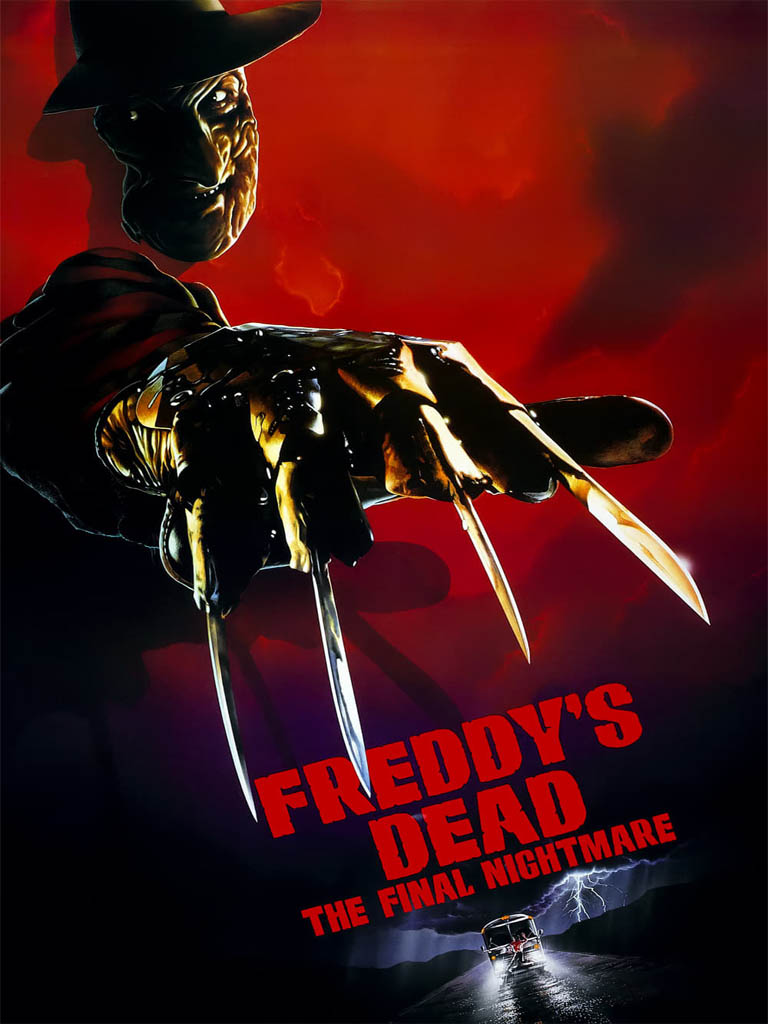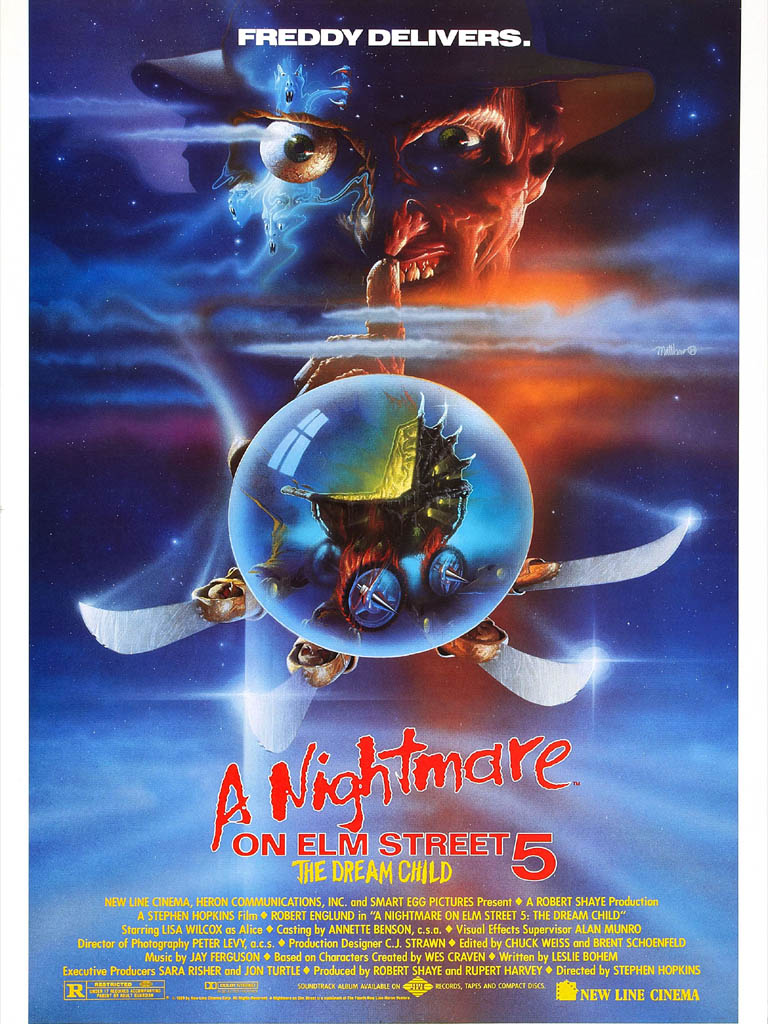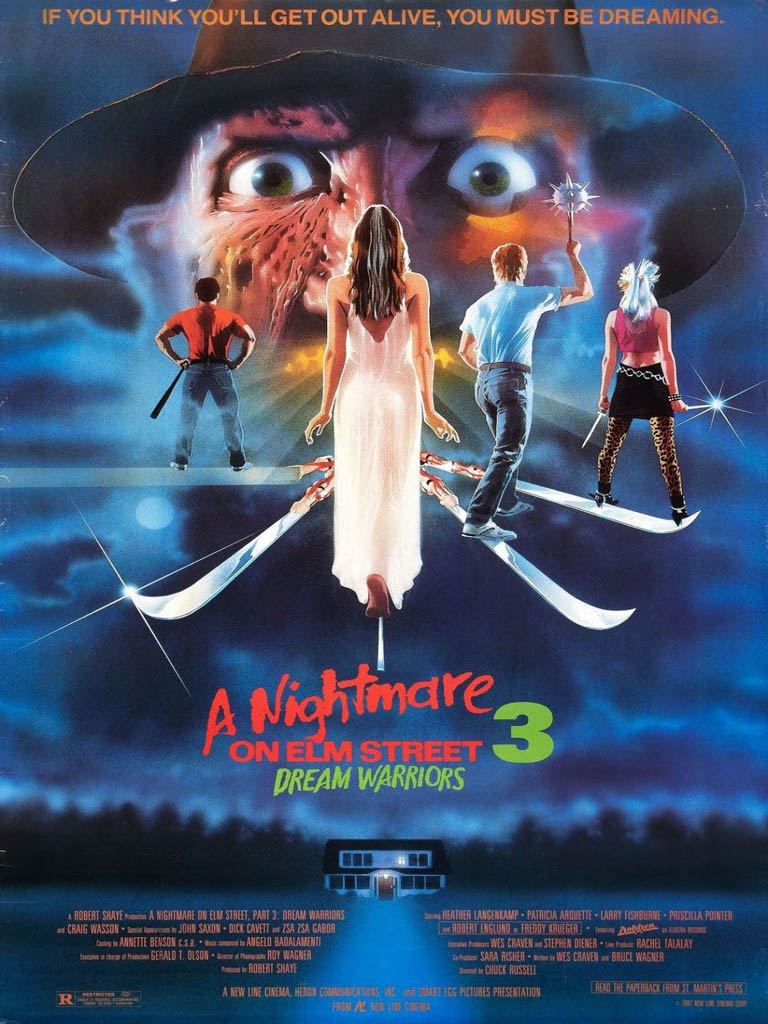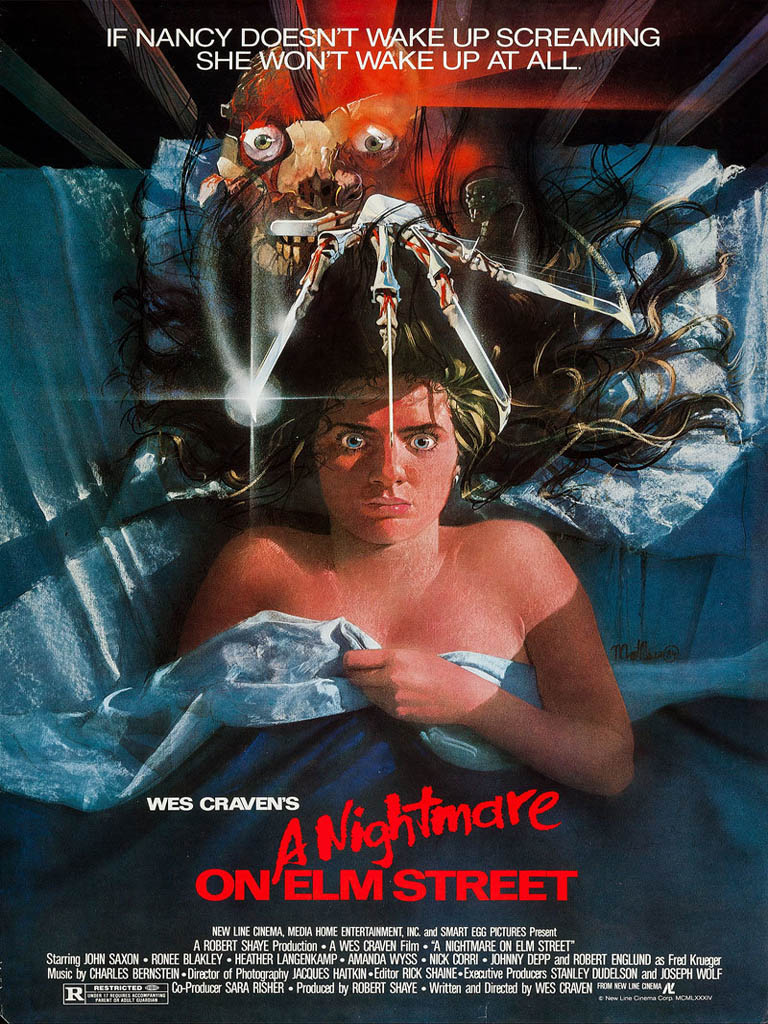(Don’t) pardon the pun, but the late Wes Craven probably never dreamed that his feature film about a supernatural serial killer would take off the way it did. Released six years after Michael Myers scared the bejeezus out of audiences in John Carpenter’s Halloween (1978), A Nightmare on Elm Street instantly slashed its way onto the scene and Freddy Krueger became the new boogieman of the horror-slasher sub-genre. Played by Robert Englund, Freddy was a sociopathic child murderer in the town of Springwood, Ohio in the 1960s. He frequently targeted children on the titular Elm Street, killing them with custom-welded razor gauntlets. Eventually, he was brought to justice but freed on a technicality. As a result, a mob of parents (most were those of the murdered children) took vigilante action. They trapped Freddy in his boiler room and burned him alive. He returned in the 1980s as a ghost who invaded the dreams of the remaining Elm Street teenage children, killing them for revenge. Their impending deaths were usually signaled by a group of white clad girls jumping rope to a creepy interpolation of the children’s nursery rhyme “One, Two, Buckle My Shoe”. With his burned face, dirty red and green sweater, fedora, and his trademark razor glove, Freddy Krueger became synonymous with the term “bad dreams”. Elements of oneirology and of psychology (lucid dreaming, hypnosis, psychoanalysis, sexual desire, et. al.) were repeatedly incorporated into each film since the inception. There are plenty of trademarks for the series as well: Each ending lets us know that Freddy’s not gone; he was limited to haunting children on Springwood’s Elm Street; each film is roughly 90 minutes; the lead protagonist is usually a White female; an extremely sliding timeline (the sequels’ plots take place anywhere from 1 to 5 to 10 years after one another, yet there’s no real change in the settings, music, or technology); and the parents are tellingly useless after they dispensed their mob justice on Freddy.
Like all of the slasher films during that decade, many NoES sequels were released to cash in on the phenomena. The franchise’s production studio, New Line Cinema, owes its whole existence to the NoES film series. The franchise’s collective gross put New Line Cinema in big leagues, with the apropos nickname, “The House That Freddy Built”. As the sequels progressed, Freddy became more of a wisecracking comedian and the series became a horror comedy, near-completely deviating from the nightmare horror that Mr. Craven originally envisioned. I grew up watching the entire series multiple times and even had a brief spell of wanting to sleep with the lights on because of it. I re-watched all six films recently and, in the spirit of Halloween, decided to do a list of the worst to best of them. FYI, this list excludes the 2010 remake as well as 1994’s Wes Craven’s New Nightmare, the latter being Mr. Craven’s metacommentary on the series and not part of its continuity.
6.)
FREDDY’S DEAD: THE FINAL NIGHTMARE
Release Date: September 18th, 1991
Synopsis and Thoughts: This is the final film of the continuity and its worst. With this film, the franchise completely embraced its labeling as a horror comedy and had some self-referential moments. The opening credits start off with a rock song, and then quotes from Friedrich Nietzsche and Freddy. Taking place 10 years after the previous film, the new protagonist is now Maggie Burroughs (played by Lisa Zane), a child psychologist. A young Breckin Meyer appears as Spence, a stoner rich kid. The group is rounded out by the hearing-impaired Carlos and a fighter named Tracy. A teenager named John Doe appears at the shelter where Maggie works and is the last surviving teen of Elm Street. While going through his possessions, Maggie finds a newspaper clipping of Loretta Krueger, a missing woman which leads her back to Springwood, now a creepy superstitious town. Freddy killed all of the kids on Elm Street, so now the town’s adults are deluded with post-traumatic stress. Roseanne and Tom Arnold also make an appearance, credited as “Mr. & Mrs. Arnold” and added more to humor element rather than the horror. One kid even describes the town as “Twin Peaks”. The town-folk are Stepfords driven crazy by and obsessed with Freddy. While there, Maggie and company learn that Freddy fathered a daughter who taken away from him in 1966. With no more people to kill on Elm Street, Freddy wants to use his daughter to take him beyond Springwood’s confines to children on every other Elm Street in America.
The film establishes Freddy’s background in flashback sequences, but that’s its only redeeming quality. The scene where he kills Carlos was prolonged with lots of bland hearing gags. Johnny Depp makes an appearance in Spence’s drug dream, in it, Freddy kills Spence in a corny video game sequence. Maggie delves more into what happened to Freddy’s child while her colleague, Doc (played by Yaphet Kotto), demonstrates full control over his dreams and teaches it to the group. Maggie learns that she’s Freddy’s daughter (her birth name is “Katherine Krueger”). Freddy’s upbringing was also a typical Freudian excuse: He got mocked and ridiculed as an orphaned child of rape and for his early sociopathic tendencies (he killed the classroom pet hamster with a hammer!), he had an abusive stepfather, engaged in self-mutilation as a teen, but tried to be good when he married a Loretta and had a daughter with her. But Freddy couldn’t deny what he is at heart: A killer. They even show him killing Loretta in front of his child and the mob that eventually torched him. During that scene, we learn how we invades dreams after death. A group called the dream demons look for the most evil human being and give him the power, after death, to “cross the line”. That supernatural explanation of his powers didn’t sit well with me because the dream demons were silly and done with some poor special effects. The film rehashes many old plot elements, such as the old “kill him if we bring him into the real world” method. The “Sticks & Stones…” line summed up why Freddy is unkillable and referenced his defeats in the previous films. The use of 3-D glasses to protect themselves in the dream world was laughably dumb, even though it helped to kill Freddy in the end. Freddy was at his least scary in the final film, but the character’s popularity persists. The movie’s ending credits consisted of a montage of the previous films similar to the end credits of Rocky V (1990).
5.)
A NIGHTMARE ON ELM STREET 4: THE DREAM MASTER
Release Date: August 19th, 1988
Synopsis and Thoughts: The fourth installment was directed by Renny Harlin (Die Hard 2, Cliffhanger, The Long Kiss Goodnight) and was the highest grossing film of the franchise. Harlin hadn’t yet found his niche as an action movie director, so his vision of NoES has cheesy visuals and boring deaths. The Dream Warriors protagonist Kristen Parker makes her return, but it’s now Tuesday Knight who plays her, not Patricia Arquette. The film begins with Kristen and the survivors from the previous film (her, Joey, and Kincaid are the last of the Elm Street children). Alice (played by Lisa Wilcox) is Kristen’s repressed best friend, though she daydreams with her id on full display.
I know Freddy comes back every film, but having flaming dog urine resurrect him from his junkyard burial was gross and inexplicable. Kincaid is the first victim of the newly resurrected Freddy, making me wonder if this is where the “Blacks are first to die in horror movies” trope began. Freddy kills Joey, and finally Kristen. In a nice call-back, Kristen is buried with Nancy Thompson, Nancy’s father, Joey, Kincaid, and the rest of the dead Elm Street kids. Kristen died, but not before she gave Alice her power to pull people into her dreams, which only added on to Alice’s innate ability to have her dreams under control (hence, the titular dream master). As Freddy picks off more of her friends, Alice also inherits the strength and skills of each as Freddy kills them. She parallels Nancy Thompson in many ways, most noticeably in how her father’s also a drunk and her level of dream manipulation. The way Freddy kills his victims is by using their fears against them, but he becomes very Kafka-esque by turning one insect-fearing female victim into a roach and then killing her via a roach motel. Alice herself is very predictable, especially with that cheeseball prep-scene of Alice taking control of her life and bringing out her inner badass amidst the backdrop of an ’80s rock anthem (all the music used reflects the MTV generation of the time). She fights Freddy with her friends’ combined skills and he is defeated when Alice makes him see his own reflection.
4.)
A NIGHTMARE ON ELM STREET 5: THE DREAM CHILD
Release Date: August 11th, 1989
Synopsis and Thoughts: This entry in the franchise has several visual gags, but also teenage issues that went with its characters (teen pregnancy, alcoholism, single parenting, eating disorders). Lisa Wilcox returns as Alice and starts the film off with a lovemaking tryst with her boyfriend, Dan. Freddy’s once again managed to hurl himself back from death’s door and wants to use Alice’s unborn child to reincarnate himself. Amanda Krueger, Freddy’s mother, returns and is a little more fleshed out here than in the third installment (here, she’s younger and less creepy). Alice’s dreams in the beginning start off with implied imagery of Amanda’s rape. Alice Witnesses Freddy’s birth in her dreams and his return to form. In the rape scene, it’s worth noting that Robert Englund cameos as one of the rapists, implying that he may be Freddy’s biological father, perhaps.
Alice & friends graduate high school, but are marked with their own issues, like Greta being a prospective cover girl on a strict diet. One thing I liked about this film was the creepy and cooler rendition of the Freddy nursery rhyme (replacing the final part of it with “9, 10, He’s back again“). Dan dies an alcohol-implied “need for speed death” and looks like a tech mock-up combo of Darkman and the Ghost Rider. Mark, the nerdy comic book fan of the group, is drawn into a comic book dream where Freddy kills him in a hilarious fashion. Despite all of Freddy’s power, he is clearly afraid of his momma. When Alice starts having these nightmares again, her friends don’t listen at first and are gradually picked off. The final battle frees Amanda’s soul, and has Alice’s and Dan’s unborn child (already named Jacob and with his own dream avatar) prevent Krueger from using him as vessel through which he can be reborn. Freddy is pulled back into Amanda, but of course, he can’t be contained. Alice and her friend Yvonne are the sole survivors, Jacob is born months later. Visually, it’s the most entertaining entry of the series, but with more religious imagery than the previous and subsequent installments.
3.)
A NIGHTMARE ON ELM STREET 2: FREDDY’S REVENGE
Release Date: November 1st, 1985
Synopsis and Thoughts: The first sequel released a year after the original, NoES 2 takes place five years after the events in the first film. This sequel was never scary to me, but it is the most psychologically interesting film in the whole franchise. The Walsh family has moved into the old Thompson house on Elm Street and their son, Jesse, is plagued by nightmares of a burned man with razor fingers. He eventually finds Nancy Thompson’s old diary in the house which detailed her experiences with Freddy Krueger. It’s subtly implied that Jesse’s a closeted gay teen, and that Freddy is using Jesse’s psychosexual development to regain form in reality. Freddy manifesting in the real world deviated from Wes Craven’s creation. Additionally, Craven had no involvement in this sequel. Also a shift from NoES conventions is that the lead in this film is a White male protagonist.
I had my dad rent this film for me several times when I was in elementary school because the imagery fascinated me and Freddy really developed his deep-gravelly voice here, completely different from the first film. However, I didn’t pick up on the film’s homoerotic subtext until adulthood, and when the director confirmed it. The actor portraying Jesse is an openly gay actor named Mark Patton, and his casting was confirmed as intentional. He played Jesse with a certain over-dramatic campiness at times. One interpretation is that NoES 2 is a metaphor coming out, but disguised as a slasher film. Kim Myers scores points Jesse’s ginger-haired potential love interest, and the scene where he nearly makes love to her but backs off has a nice subtle nod to the film’s subtext. Overall, the film relied on cheap special effects, culminating with a swimming pool massacre which looked stupid AF. But even with a male lead (Mark Patton is the first male scream queen, ya’ll) and unique social commentary/interpretation of Freddy, it doesn’t add to the NoES mythos. In many ways, it’s like the Halloween III of the NoES films.
2.)
A NIGHTMARE ON ELM STREET 3: DREAM WARRIORS
Release Date: February 27th, 1987
Synopsis and Thoughts: Wes Craven co-produced and co-wrote the screenplay for the third installment. In retrospect, this is the true sequel to the original, getting it back on course due to Craven’s influence. But this is also when the films began to have humor. Future stars Patricia Arquette (in her film debut) and Laurence Fishburne have large roles here as the newest female protagonist and an asylum orderly, respectively. Arquette plays Kristen Connor, a troubled teen having nightmares of the Thompson family’s now abandoned and dilapidated house on Elm Street. It isn’t long before her mother places her in a psych ward with a new generation of kids all having the same nightmares as her. Kristen learns that she has the ability to pull others into her dreams. Heather Langenkamp returns as Nancy Thompson, now a graduate student researching dreams. Nancy, a survivor, teaches the kids how to fight back and take control of their dreams.
As stated earlier, this film is where much of the humor that came to define the series began, along with plenty of James Bond-esque one-liners courtesy of Freddy. One of the kids is an aspiring television actress named Jennifer. Freddy kills her by transforming himself into a TV and smashing her head into his screen (“Welcome to prime-time, bitch!“). Joey, a mute trauma patient in love with a blonde nurse, is seduced by a disguised Freddy. Though not killed, Joey is bound to his bed by several tongue ropes (“What’s wrong, Joey? Feeling tongue-tied?“). He kills the drug-addicted Taryn in her dreams by transforming his knives into heroin needles (“Let’s get high!“). Freddy also starts using the teens’ dreams to tailor their deaths to fit their vice or disability. This film also began the played-out “we’re the last of the Elm Street children” theme. It also adds depths to Freddy’s backstory via his mother, Amanda Krueger, who aids them with an added religious angle to defeating Freddy. This time, they found his remains in a junkyard and gave him a consecrated burial, laying his spirit to rest, but at great cost. This film is also notable for the introduction of the character of Kincaid, the sole Black teen of the group and the franchise’s first attempt at diversity. The music was also a plus: The foreboding score was laid down by composer Angelo Badalamenti and glam-metal band, Dokken, provided the song “Dream Warriors” and its accompanying video.
1.)
A NIGHTMARE ON ELM STREET
Release Date: November 9th, 1984
Synopsis and Thoughts: There are four main teens (Rod, Tina, Glen, and Nancy) stalked by Freddy Krueger in their dreams. They don’t know why he’s targeting them, but if he kills you in your dreams, you’re dead in reality. This is where the nightmares and Freddy Krueger began. The first NoES film with Wes Craven’s involvement, as he wrote and directed the film. This is Robert Englund’s first stab as Freddy Krueger and he comes off as the real boogieman, albeit an unkempt one. The film’s low-budget doesn’t rely on special effects, but opts for genuine scares instead. Like Halloween before it, this film brought slasher murders to a Midwestern White suburban enclave, exposing some dark secrets of its inhabitants in the process.
Wes Craven was never one to shy from a wry sense of humor: He includes meta-commentary in the script with one line about age, particularly Nancy Thompson’s “I look like I’m 20-years old” line (Heather Langenkamp was in fact the same age at the time the film was released). It’s also worth noting that this is Johnny Depp’s film debut, playing Nancy’s doting boyfriend, Glen. The film uses the nightmares to represent themes of teenage alienation, especially from their parents. The parents in this film are useless, they’re either too drunk or too self-absorbed to truly help their kids. The film succeeded because it combined slasher films with supernatural Freudian elements, blurring the line between dreams and reality to the point where audiences were left mystified.








